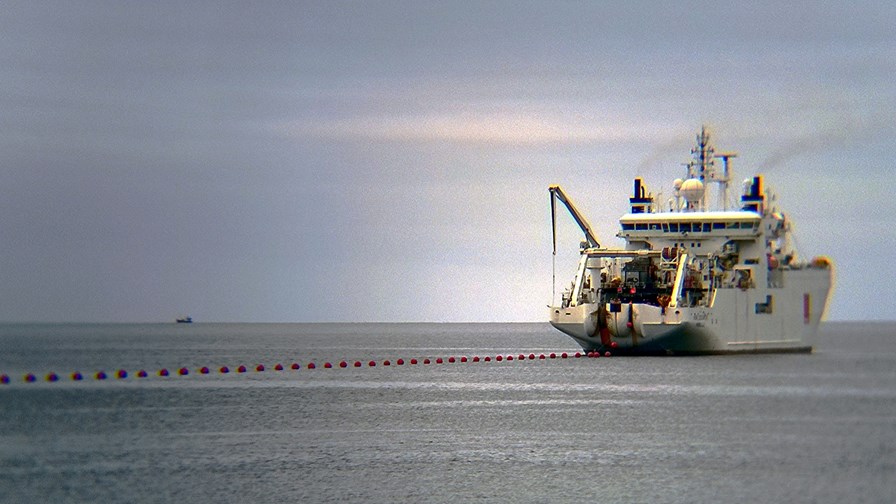
Cable Ship Rene Descartes © Flickr/cc-licence/Mark Stainton
- Rising sea levels threaten 4,000 miles of cable from New York to Miami
- 1,100 PoPs, traffic hubs and co-location sites likely to be permanently flooded
- Houston, we definitely have a problem
- Sink or swim time
Sounds apocalyptic doesn't it? And it could be, but not for a few years yet. A new research study tapping into the combined brainboxes of boffins at the University of Wisconsin, Madison, the University of Oregon in the US and the Applied Networking Research Workshop in Montreal, Canada concludes that global warming/climate change will result in the briny inundation of thousands of miles of fibre-optic cable, mainly along the Eastern seaboard of the USA from New York to Miami.
The American popular press and local TV stations have been getting hysterically Old Testament about the report but a not particularly close reading of it shows that what is at potential threat is not international subsea cables, which are by definition and design, totally waterproof, but broadband fibre-optic cables buried on US beaches and coastal reaches over the past 30 years or so which are "water resistant" rather than "waterproof".
The new study concludes that 4,067 miles of cable (including some in the Houston area of Texas and around Seattle in the Pacific Northwest) that were buried in coastal lands will be under water by 2033 as sea levels continue to rise. More than 1,100 traffic hubs, points of presence and co-location sites could also be permanently flooded by the same date.
Obviously, the solution will be to dig up the threatened networks and move them further inland (and to higher ground wherever possible). It'll be expensive and troublesome but there is still time to do it, if plans of action are written and agreed now. Whether or not they will be remains to be seen.
Little consideration was given to the possibility of rising sea levels as a result of climate change when the cables were deployed a generation and more ago but, as the problem gets worse much more quickly than was anticipated by even the most pessimistic Jeremiah's of the day, it is evident that some contingency planning needs to be done soon. As Paul Barford, one of the senior authors of the report and a professor of Computer Science at the University of Wisconsin, Madison says. “Most of the damage that’s going to be done in the next 100 years will be done sooner than later. We thought we'd have 50 years to plan for it. We don’t.”
An inescapable problem?
The report cites AT&T, CenturyLink and Inteliquent as the three companies with the most infrastructure at risk and urges that they come up with solutions to what seems likely to be an very long-term and inescapable problem as soon as possible. It's not as if there are no precedents; natural disasters such as hurricanes Irma and Katrina (that devastated the US Gulf Coast region and destroyed the 9th Ward of New Orleans) literally drowned operator networks and otherwise played merry hell with telecoms infrastructure. Outages lasted for months.
The report, "Lights Out: Climate Change Risk to Internet Infrastructure" was compiled by creating projections from the comparison of Internet infrastructure sites with sea level rise inundation data from the National Oceanographic and Atmospheric Administration of the US Department of Commerce. It points out that the metro areas most at risk lie along the coastline from New York in the Northeast down to Miami in the Southeast as well as taking in the enormous low-lying areas in and around Houston in Texas.
The study cites the major problems as being signal attenuation as a result of water molecules embedding themselves in "micro-cracks" in fibre optic cables, seawater corrosion damage to connectors, signal loss in optical-electrical-optical cross connects and fibre degradation, cracking and breaking as a result of seasonal freezing.
The authors call on affected state, telcos, operators and broadband service providers to immediately put in place “mitigation planning" for the hardening of critical infrastructure in vulnerable areas and "exploring the possibility of integrating inter- and intra-domain routing substrate to create backup and alternative routes to reduce the impact of coastal infrastructure failures." Unsurprisingly, the report also calls for future deployments of Internet infrastructure to be planned for and executed with the impact of climate change in mind. Fifteen years and counting…..
Email Newsletters
Sign up to receive TelecomTV's top news and videos, plus exclusive subscriber-only content direct to your inbox.




